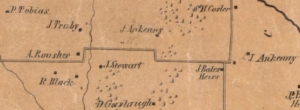
Brett Williford
Re-introducing you to the Beavercreek you love... from 1803 to today!
The wooded area on either side of Dayton-Xenia Road is the 44.439 acre Ferguson Land Laboratory. The Fergusons were prominent farmers since the settling of Beavercreek and by the 1940’s were the largest growers of potatoes in the area. They donated this land to the Board of Education with the stipulation that it remain forever untouched woodland.
Completed in 1954, the present Beavercreek High School was built adjacently upon 33 acres of Ferguson land that was purchased by the Board of Education and the Ferguson Hall Campus behind sits on another sixteen acres that was donated by brother and sister Edwin and Lida Ferguson.
 BHS Looking East
BHS Looking East
BHS Looking East
BHS Looking East
 BHS 1966
BHS 1966
BHS 1966
BHS 1966
 BHS 1978
BHS 1978
BHS 1978
BHS 1978
 BHS 1983
BHS 1983
BHS 1983
BHS 1983
 BHS Under Construction
BHS Under Construction
BHS Under Construction
BHS Under Construction
 Banned At BHS
Banned At BHS
Banned At BHS
Banned At BHS
 BHS
BHS
BHS
BHS
https://beavercreekliving.com/beavercreek-blog/itemlist/user/23-brettwilliford?start=40#sigProId0f841e7f4d
Please turn right at the stoplight onto Dayton-Xenia Road. In 1887, Beavercreek High School opened, the second high school in the state. Twenty pupils enrolled and classes were held on the second level of the old Stage Coach Inn while the new building was under construction.
Upon completion in late 1888, the students marched their tables, chairs, and books up the street to the new building. This new school gave the students a lot more room. Instead of a whole 'grade level' being at one table, there were only four students to a table.
The south room was used for Freshmen and Sophomores, the north for Juniors and Seniors. Upstairs, smaller rooms were used for smaller classes. In 1914, two more rooms, one for science and one for home economics, were added to the west end of the building to accommodate the increasing population. The first class to graduate from Beavercreek High School was in 1891 with eleven students.
Just to the southeast of the school, pictured below c.1930, is the vocational and agricultural classroom which also served as a horse barn and farrier shop.
In 1915, two more rooms were added. The school was eventually outgrown and moved a bit west.
 First Graduation
First Graduation
First Graduation
First Graduation
 1888 BHS 1
1888 BHS 1
1888 BHS 1
1888 BHS 1
 1888 BHS 2
1888 BHS 2
1888 BHS 2
1888 BHS 2
 Reunion of Old Beaver
Reunion of Old Beaver
Reunion of Old Beaver
Reunion of Old Beaver
 BHS And Vocational
BHS And Vocational
BHS And Vocational
BHS And Vocational
 Class Photo
Class Photo
Class Photo
Class Photo
 Lamachys Menu
Lamachys Menu
Lamachys Menu
Lamachys Menu
 Don't Get Shook
Don't Get Shook
Don't Get Shook
Don't Get Shook
https://beavercreekliving.com/beavercreek-blog/itemlist/user/23-brettwilliford?start=40#sigProId29d3b67f3d
The areas east and west of Beaver Valley Road and south to Obetz Drive were 334 acres owned by Jacob Herring. When the settling of Beavercreek was still underway, Mr. Herring who owned a tract of land near the creek in Alpha, heard that a fertile ground north of town was available. General Benjamin Whiteman Jr., Major General during the War of 1812, famed leader of expeditions against the Shawnee, son-in-law of pioneer Owen Davis and one of the area’s original settlers, learned of Herring’s desire to acquire the land. He approached Herring and negotiated a price of five dollars per acre for the tract. Unbeknownst to Mr. Herring, the land was an unclaimed land grant and not owned by General Whiteman. After consummating the deal, Whiteman immediately went to Cincinnati and entered it into his own name at less than two dollars and fifty cents per acre. He then re-sold the land to Mr. Herring for nearly a thousand dollar profit!
This land now includes Grace Crossing Church (Howell’s Orchard), Rona Village Condominiums and the entirety of Hunter’s Pointe! Beyond Obetz Drive is the 279 acre property that was owned by William C. Cline. It encompasses Oakbrook Chase as well as Hunter’s Ridge One and Two.
 Herring House 1
Herring House 1
Herring House 1
Herring House 1
 Herring House 2
Herring House 2
Herring House 2
Herring House 2
 Howell's Orchard
Howell's Orchard
Howell's Orchard
Howell's Orchard
 Hunters Ridge / Hunters Pointe
Hunters Ridge / Hunters Pointe
Hunters Ridge / Hunters Pointe
Hunters Ridge / Hunters Pointe
 Martha Stauffer Murder 1
Martha Stauffer Murder 1
Martha Stauffer Murder 1
Martha Stauffer Murder 1
 Martha Stauffer Murder 2
Martha Stauffer Murder 2
Martha Stauffer Murder 2
Martha Stauffer Murder 2
 Stauffer Home on Beaver Valley
Stauffer Home on Beaver Valley
Stauffer Home on Beaver Valley
Stauffer Home on Beaver Valley
https://beavercreekliving.com/beavercreek-blog/itemlist/user/23-brettwilliford?start=40#sigProId9a24c5e393
As you continue south on Beaver Valley Road, look to your right as you exit the s-curve, this was another stone quarry that provided stone for the eastern portion of the township. Local men and boys would hand shovel and deliver stone slabs and gravel from the quarries to earn additional money.
This quarry was located on the Jacob Herring farm in 1874.
https://beavercreekliving.com/beavercreek-blog/itemlist/user/23-brettwilliford?start=40#sigProId2eac0e7f40
Continuing south you’ll find the Cozad-Phillips House (also known as The David Gray Elm Home) at 1823 Beaver Valley Road. Perched majestically on the western ridge of the Beaver Valley, it was built on 200 acres by John Cozad in 1856. The Federal-style farmhouse was originally built in the shape of a cross, its corners eventually filled in by additions. The original roofing was of cedar shakes, the soffits of 24” wide by 1” thick walnut boards and the box gutters were of copper. The interior woodwork is all of walnut. It was plumbed and wired for electric around 1918 when electricity was first brought to Beavercreek.
The second owner of the home and alternate namesake, David Gray, was one of the few successful 49’ers from the California gold rush of 1849. He purchased the home on May 11, 1866 for $8,820, ostensibly with California gold earnings. Later, the home suffered tremendous neglect. In 1994 it was purchased by Ed and Diane Phillips of Beavercreek and extensively restored into the beautiful estate you see now.
 Cozad-Phillips House
Cozad-Phillips House
Cozad-Phillips House
Cozad-Phillips House
 The Beaver Valley
The Beaver Valley
The Beaver Valley
The Beaver Valley
 David Gray
David Gray
David Gray
David Gray
 Prohibition Ticket
Prohibition Ticket
Prohibition Ticket
Prohibition Ticket
https://beavercreekliving.com/beavercreek-blog/itemlist/user/23-brettwilliford?start=40#sigProIde1078b6aae
The second 90° turn is home to the William Tobias House at 2057 Beaver Valley Road, built about 1820. Formerly known as Broadview Farm, this is located on an old Shawnee Indian trail. William Tobias had been a tenant farmer in Sugarcreek Township and purchased a log home and 86 acres in 1869. He replaced it with a two-story mortised and pinned frame structure prior to 1879.
The William Tobias House is now owned and maintained by local developer, Bob Mills.
At the first 90° curve sits the Gerlaugh-Tobias House built by David Gerlaugh in 1821. Built in the vernacular style with Shaker influences, the foundation walls are of brick and there is a full basement – very unusual for the era. The Siebenthaler Company bought it in 1979 and is preserving the historical integrity of the home.
An ancient Siberian Elm dominates the front yard. OSU has designated it the largest elm of its kind in the United States.
https://beavercreekliving.com/beavercreek-blog/itemlist/user/23-brettwilliford?start=40#sigProId92c73b4189
There are numerous stories of haunting in Beavercreek; one takes place just to the northeast of here! If heading to the former town of Byron, Trebein road is haunted by the ghost of a woman who was flung from her carriage after it hit a rock and died (on her wedding day). Her father and fiancée dug up the rock and tossed it to the side of the road where it remains today. She is seen wearing her white wedding dress, often near the time of her anniversary or birthday. Some believe that if you stop and she touches you that you will become old and she will be young and beautiful again. We’ll avoid the area to help preserve your youth – just in case!
Share your stories below!
We’ll be heading south, but it’s interesting to note that at the slight left jog in the road on the west side of Beaver Valley Road at 2533 was the Howard wagon shop in 1855. Later, in 1874, the land was owned by Sam Cosler. The land east of Beaver Valley is now known as the Siebenthaler Nursery. Please turn right and head south on Beaver Valley.
If you’re able, pause for a moment at the stop sign at Beaver Valley Road. If you look across the fields before you, was once a 153 acre tract designated as Ohio School Lands. The school there was once presided over by Amos Quinn – an amiable man not to be crossed by any rebelliousness of his pupils. It was customary during Christmas time for students to bar the school’s door, keeping the teacher out until they could compel a “treat” out of him.
Once, the boys barred Quinn from the building, after exhaustive attempts to enter doors and windows, he climbed to the roof and began tearing clapboards from the schoolhouse. The noise attracted the attention on the locals, who gathered to watch. Upon dropping to the floor, he was seized and securely bound until he was glad to surrender the apples and cider he had procured from a neighbor for his pupils. The temporarily suspended course of education was then allowed to resume as intended!
Continue east on Kemp Road through two 90° curves. The rural land in this area was settled by the Ferguson, Stewart, Gerlaugh, Ankeney and Tobias Families and later some was purchased by the Howard, Greene and Bates’. Near the second set of 90° curves are several large-tract estate lots.
On the left is the 80+ acre ‘Russ Property’ that was the homestead of local businessman and philanthropist Fritz Russ. He donated his land to Greene County, it's now known as the 'Russ Nature Reserve'.
Latest Blog Posts
- Just Don't Call Us Late For Dinner...
- Remember When...
- What A Long, Strange Trip It's Been...
- Snow Down = Slow Down
- School Bus Safety - Just Do It!
- Stevenson Road Covered Bridge
- Our Road Crews Are Worth Their Salt!
- The Most Colorful Of Seasons!
- Popcorn Fest! - Then And Now
- Pre-School Paradise!
- Remembering Riffles
- Ten Year Anniversary Of The Beaver Statues














